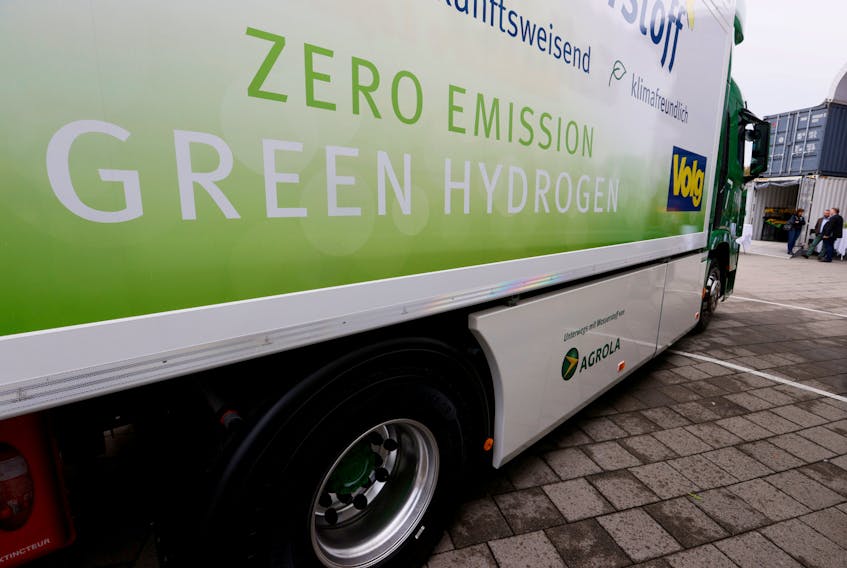LARRY HUGHES • Guest Opinion
Earlier this month, as part of its plan to show how Nova Scotia could reach net zero emissions by 2050, OERA (Offshore Energy Research Association) released a report on the potential of using hydrogen as an energy source in the Maritime provinces.
The report argued that hydrogen could make up 22 per cent of the region’s energy mix by 2050. To meet this target, the region will require a source of hydrogen. Since the atmospheric concentration of hydrogen is about six parts per million by volume, there is little point in trying to extract it from the air, which means it needs to be produced from a hydrogen-rich compound, typically water (H2O) or natural gas (methane or CH4).
As most readers will recall from their high school chemistry class, hydrogen can be extracted from water using electrolysis. By running a current through water, hydrogen is produced at the cathode and oxygen at the anode. Industrial-scale electrolysis requires a firm (i.e., continuous) supply of electricity.
Hydrogen can also be produced from water using a Polymer Electrolyte Membrane (or PEM) cell. PEM has the advantage over electrolysis in that it can use variable sources of electricity (i.e., wind or solar). Getting hydrogen from methane is achieved using a process known as SMR (Steam Methane Reforming, not Small Modular Reactor!). As the name suggests, steam reacts with methane to produce hydrogen. Unlike electrolysis and PEM, which produce hydrogen and oxygen, SMR produces hydrogen and carbon dioxide. To reduce its emissions, the OERA report assumes the SMR technology will use some form of CCUS (Carbon Capture Utilization and Storage).
Since most of the region’s electricity is carbon-intensive (Nova Scotia’s more so than New Brunswick’s), any hydrogen produced in the region (from electricity or SMR) will be carbon-intensive. Once the hydrogen is extracted, it needs to be made available to potential customers. Fortunately, the natural gas network in the region uses polyethylene piping, which, unlike older networks using metal pipes, will not degrade if hydrogen passes through them.
Moreover, natural gas can be mixed with up to 20 per cent hydrogen and used with existing natural gas combustion technology. However, unlike the rest of Canada, the penetration of the natural gas network in New Brunswick and Nova Scotia is extremely limited (it does not exist in Prince Edward Island) and would require a major buildout.
While there are potential industrial users (the Irving refinery is one such example; however, it already produces hydrogen from natural gas), restructuring a transit system so its buses run on hydrogen or using hydrogen-powered ferries and tugs are other possibilities.
With such a limited market, the OERA report makes the time-honoured recommendation used with many a Nova Scotian energy project: Export it. Why break with tradition? Quite simply, if the hydrogen results in carbon dioxide emissions, we will be shipping hydrogen to other countries so that they can use a clean, zero-emission fuel to reduce their emissions. As with Pieridae’s plan to build an LNG export facility in Goldboro, Nova Scotia will be responsible for the emissions.
The report also proposes transporting hydrogen from western Canada (Alberta plans to make hydrogen from natural gas) by pipeline to the Maritimes for export.
Some of you may be thinking: wasn’t this the plan behind the Energy East pipeline? Yes, but Energy East was to carry heavy crude, not hydrogen.
However, the question remains: would Quebec object to hydrogen being shipped to the Maritimes? About 25 years ago, I went to a hydrogen conference where a delegation from Germany presented a grand plan for getting hydrogen from Canada to Germany via specially constructed hydrogen tankers from Port Saguenay. The Germans didn’t consider carbon-intensive hydrogen from the Maritime provinces; their focus was to have Hydro Quebec produce it.
Although nothing came of the project, Quebec is now looking at making Port Saguenay an export terminal for natural gas. There’s nothing to say that the port couldn’t also be used for exporting hydrogen made in Quebec, or elsewhere in Canada, to Europe.
In fact, if hydrogen is to be shipped from western Canada, it would be less carbon-intensive to move it though Quebec to Port Saguenay.
While there is undoubtedly a future for hydrogen in the region, we need a clean source of energy to produce it. And if we do produce it, we need a market in the region to meet regional demand before any is exported to the United States, the European Union or elsewhere in the Atlantic Basin.
Postscript: In 1992, I co-authored a paper proposing the use of wind and hydroelectricity in Newfoundland and Labrador for hydrogen in the region. The fact that the OERA report omitted Newfoundland and Labrador as a possible source of clean hydrogen for the region was a considerable oversight, especially with the expiration of the Churchill Falls-Hydro Quebec contract in 2041.
Larry Hughes is a professor and founding fellow at the MacEachen Institute for Public Policy and Governance at Dalhousie University.









